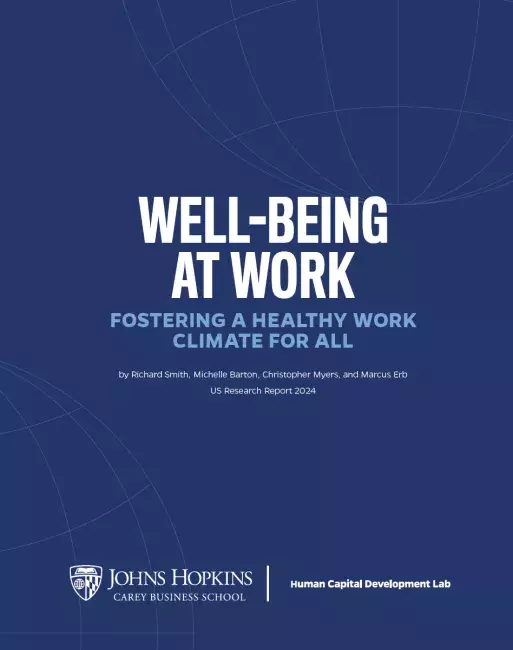Well-being at Work: U.S. research report 2024
Human Capital Development Lab
Well-being at Work U.S. research report released (2024)
Johns Hopkins researchers share new insights related to employee well-being in U.S. organizations. The study highlights the decline in the climate of workplace well-being since the COVID-19 pandemic through a comprehensive analysis of more than 4.5 million survey respondents each year. The "Climate of Well-being" report outlines organizational factors that may affect employee well-being in the workplace. The research shows that successful organizations create a climate of well-being not by providing perks or benefits, but rather they create a culture where people feel acknowledged, supported, and connected. The new insights highlight the impact of flexible work arrangements, stress levels, industry practices, and persistent disparities among groups of people in the workplace.

Well-being at Work
Fostering a Healthy Work Climate for All
The research shows that successful organizations create a climate of well-being not by providing perks or benefits, rather they create a culture where people feel acknowledged, supported and connected. The new insights highlight the impact of flexible work arrangements, stress levels, industry practices, and persistent disparities among groups of people in the workplace.
Employees report a post-pandemic decline in the climate of workplace well-being
Washington, D.C. — August 28, 2024 — How do employees experience the climate of their workplace when it comes to well-being? As it turns out, this varies by industry, demographic group, and organization, according to new research led by Johns Hopkins Carey Business School’s Human Capital Development Lab.
The link between employee well-being and performance has prompted leaders with motivation to explore how maximizing these once-overlooked factors may be central to increasing organizational success. However, achieving high levels of employee well-being is a feat that’s easier said than done.
The Well-Being at Work report uncovers the latest insights on organizational and individual factors that may influence employee well-being in the U.S. The study showcases the rise and decline of the climate of employee well-being across industries over the past five years, while considering influences like tenure, management level, confidence, and work arrangements, along with demographic differences based on race, gender, and age.
“Improving employee well-being can be complex – our research highlights a need for leaders to address organizational culture factors coupled with a more nuanced management approach to create a climate of well-being for all,” said Professor Rick Smith, faculty director at the Human Capital Development Lab and co-author of the study.
The overall findings show what many employees experienced in the first year of the COVID-19 pandemic: organizational leaders addressing the impact of this crisis by taking extra care to meet employee needs. The report shows that employees experienced a spike in the positive climate of well-being at the early periods of the pandemic. However, as workplaces transitioned back to pre-pandemic norms and more employees return to physical office spaces, the overall climate of well-being often regressed to the pre-pandemic level.
Associate Professor Michelle Barton, co-author of the study, adds, “The Covid pandemic heightened employers’ awareness of the importance of well-being, and many of the best organizations worked to create a positive work climate. The challenge now, will be to integrate those practices into everyday work life, rather than simply as a crisis response.”
The data from the report confirms that there is a link between remote work opportunities and a climate of well-being, suggesting a need for employers to address work-life balance challenges for the workforce. However, since managers typically encounter lower stress levels than their junior employees, some managers may not fully appreciate these needs. This research also highlights some important differences by gender and ethnic groups, showing that well-being in the workplace is still consistently lower for women and African Americans.
Interestingly enough, researchers also completed a comparison analysis of the climate of well-being between the top 100 companies listed in the Fortune 100 Best Companies, as recognized by Great Place To Work®, and non-ranked companies in 2023. They found that ranked firms have significantly higher employee well-being scores, further strengthening the potential link between employee well-being and organizations recognized as great places to work.
This research leverages data from Great Place To Work®, the world’s leader in identifying best workplaces. The flagship data was gathered using a proprietary employee survey, known as The Trust Index™ survey, which is administered to over 5000 organizations and over 4.5 million survey respondents each year around the world. To quantify a climate of well-being, researchers measured several key dimensions such as: mental and emotional support, sense of purpose, personal support, financial health, and meaningful connections.
Authors of the study include Rick Smith, a professor of practice and faculty director of the Human Capital Development Lab at Johns Hopkins Carey Business School; Michelle Barton, an associate professor of practice and academic program director of the Flex MBA Program at Johns Hopkins Carey Business School; Christopher Myers, an associate professor of management and organization and faculty director of the Center for Innovative Leadership at Johns Hopkins Carey Business School; and Marcus Erb, vice president of data science and innovation for Great Place To Work.
About Great Place To Work
As the global authority on workplace culture, Great Place To Work brings 30 years of groundbreaking research and data to help every place become a great place to work for all. Its proprietary platform and For All™ Model help companies evaluate the experience of every employee, with exemplary workplaces becoming Great Place To Work Certified™ or receiving recognition on a coveted Best Workplaces™ list.
Follow Great Place To Work on LinkedIn, X, and Instagram or visit greatplacetowork.com and sign up for the newsletter to learn more.